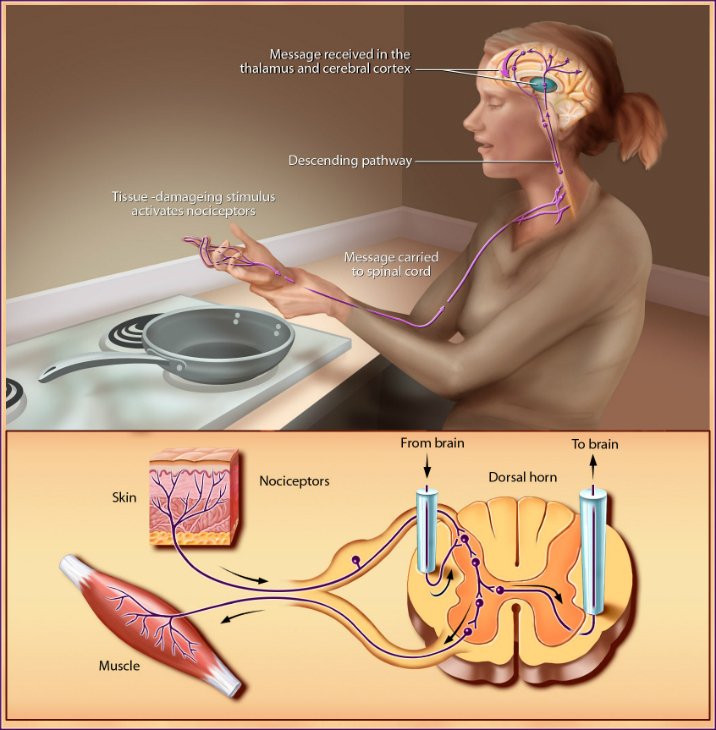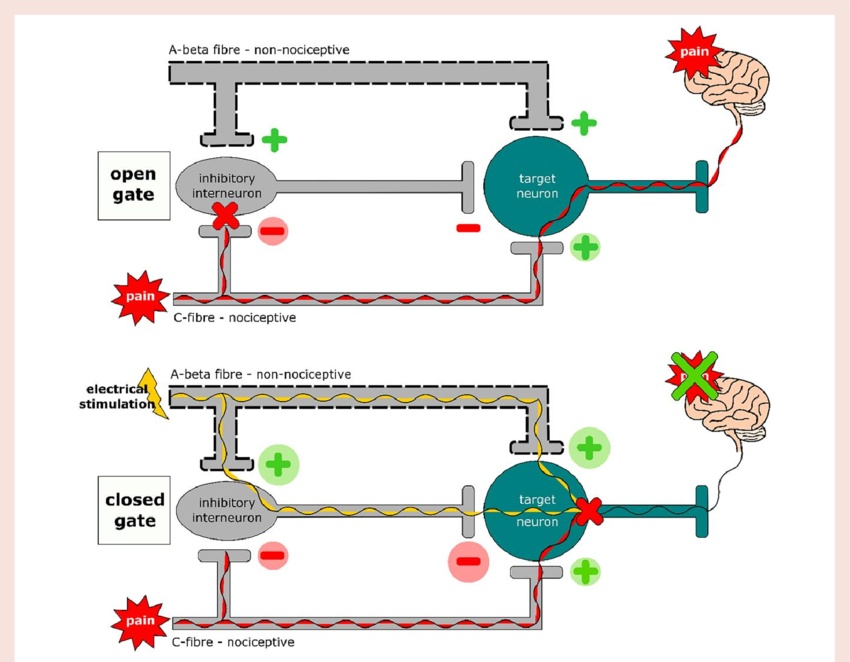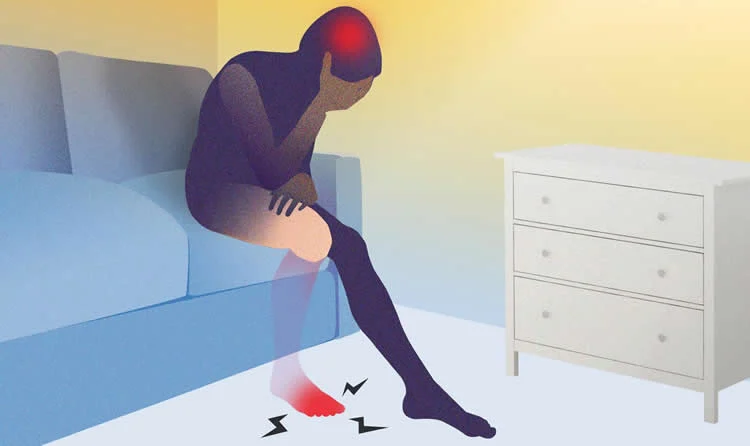Touch and pain perception are foundational to human sensory experience, allowing us to navigate our environment and respond to potential harm. This article explores the complex mechanisms behind these sensations, focusing on skin receptors, the somatosensory cortex, and key theoretical models such as the gate-control theory of pain. It also examines the phenomenon of phantom limbs, which challenges conventional understanding of sensory processing. Together, these insights offer a comprehensive view of how the nervous system interprets tactile and nociceptive stimuli.

Skin Receptors and the Somatosensory Cortex
Skin Receptors: The First Line of Sensory Input
The skin, the body’s largest organ, is densely populated with specialised receptors that detect mechanical, thermal, and chemical stimuli. These receptors are categorised based on their structure, function, and adaptation properties:
- Mechanoreceptors: These respond to mechanical pressure or distortion. Examples include:
- Merkel cells: Slow-adapting receptors for fine touch and texture discrimination.
- Meissner’s corpuscles: Rapidly adapting receptors sensitive to light touch and low-frequency vibrations.
- Pacinian corpuscles: Detect high-frequency vibrations and deep pressure.
- Ruffini endings: Respond to skin stretch and sustained pressure.
- Thermoreceptors: These detect temperature changes and are divided into:
- Warm receptors: Activated by temperatures above body temperature.
- Cold receptors: Respond to temperatures below body temperature.
- Nociceptors: These are specialized for detecting noxious stimuli that may cause tissue damage. They respond to extreme mechanical pressure, heat, cold, or chemical irritants.
Somatosensory Cortex: Processing Tactile Information
The somatosensory cortex, located in the parietal lobe, is responsible for processing sensory information from the skin and other tissues. It is organized somatotopically, meaning different body regions are mapped to specific areas of the cortex. This “homunculus” representation exaggerates sensitive areas like the hands and lips, reflecting their high receptor density.
The pathway for tactile information involves:
- Peripheral receptorsdetecting stimuli.
- Sensory neuronstransmitting signals to the spinal cord.
- Thalamic relayto the primary somatosensory cortex (S1).
- Higher-order processingin secondary somatosensory areas (S2) for integration and interpretation.
This hierarchical processing allows for the discrimination of touch, pressure, and vibration, enabling complex behaviors like object manipulation and social interaction.
Gate-Control Theory of Pain Perception
Pain is a complex and multifaceted experience that serves as a critical warning mechanism for the body. However, its perception is not solely determined by the intensity of a noxious stimulus but is also shaped by sensory, emotional, and cognitive factors. The Gate-Control Theory of Pain, proposed by Ronald Melzack and Patrick Wall in 1965, marked a paradigm shift in our understanding of pain modulation.
This theory introduced the concept of a “gate” in the spinal cord that regulates the transmission of pain signals to the brain, offering a framework to explain how non-painful stimuli and psychological factors can influence pain perception. This section explores the key principles of the Gate-Control Theory, its physiological underpinnings, and its clinical applications in modern pain management.

The Spinal Cord as a “Gate”
The central tenet of the Gate-Control Theory is the idea that the spinal cord acts as a neurological gate that either allows or blocks pain signals from reaching the brain. This gate is not a physical structure but a functional mechanism involving the interplay of different types of nerve fibres and neural pathways.
- Closing the Gate: Non-painful stimuli, such as rubbing an injured area, can inhibit the transmission of pain signals. For example, when you stub your toe, applying pressure or massaging the area can reduce the perception of pain by “closing the gate.”
- Opening the Gate: Conversely, the absence of inhibitory signals or the presence of facilitatory signals can “open the gate,” amplifying the perception of pain.
Role of Nerve Fibers
The theory distinguishes between two primary types of nerve fibers involved in pain modulation:
- A-beta fibers: These are large-diameter, myelinated fibers that transmit non-painful tactile signals (e.g., touch, pressure, vibration). When activated, they inhibit the transmission of pain signals by closing the gate. This explains why tactile stimulation (e.g., rubbing a sore muscle) can alleviate pain.
- C fibers: These are small-diameter, unmyelinated fibers responsible for transmitting slow, dull, or aching pain. Their activation facilitates the opening of the gate, enhancing pain perception.
Descending Modulation from the Brain
The Gate-Control Theory also emphasizes the role of descending pathways from the brain in modulating pain. Key brain regions involved include:
- Periaqueductal Gray (PAG): A midbrain structure that plays a pivotal role in pain suppression. When activated, it sends inhibitory signals to the spinal cord, closing the gate.
- Rostroventral Medulla (RVM): This region acts as a relay station for descending pain modulation, either inhibiting or facilitating pain signals based on cognitive and emotional inputs.
These pathways highlight thebidirectional nature of pain perception, where higher brain centers can influence how pain is experienced.
Clinical Implications of the Gate-Control Theory
The Gate-Control Theory has profound implications for pain management, providing a scientific basis for both pharmacological and non-pharmacological interventions. Below are some of the most widely used strategies derived from this theory:
Transcutaneous Electrical Nerve Stimulation (TENS)
- Mechanism: TENS devices deliver low-voltage electrical currents to stimulate A-beta fibres, thereby closing the gate and reducing pain perception.
- Applications: Commonly used for chronic pain conditions such as arthritis, neuropathy, and postoperative pain.
Physical Therapy and Tactile Stimulation
- Mechanism: Techniques like massage, acupuncture, and movement therapies activate A-beta fibres, providing pain relief by modulating the gate.
- Applications: Effective for musculoskeletal pain, sports injuries, and rehabilitation.
Psychological Interventions
- Mechanism: Cognitive-behavioural therapy (CBT) and mindfulness-based techniques influence descending modulation, enhancing the brain’s ability to suppress pain signals.
- Applications: Used for chronic pain conditions, fibromyalgia, and psychosomatic pain disorders.
Pharmacological Approaches
- Mechanism: Medications like opioids and antidepressants target descending pathways (e.g., PAG and RVM) to enhance pain inhibition.
- Applications: Prescribed for severe or chronic pain, though with caution due to potential side effects and dependency risks.
Criticisms and Contemporary Perspectives
While the Gate-Control Theory has been instrumental in advancing pain research, it is not without limitations:
- Oversimplification: The theory does not fully account for the complexity of chronic pain conditions, where structural and functional changes in the nervous system (e.g., central sensitization) play a significant role.
- Neuroplasticity: Modern research highlights the brain’s ability to rewire itself in response to persistent pain, a phenomenon not addressed in the original theory.
- Individual Variability: Pain perception varies widely among individuals due to genetic, psychological, and environmental factors, which the theory only partially explains.
Despite these criticisms, the Gate-Control Theory remains a foundational model in pain science, continually refined by advancements in neuroimaging and molecular biology.
In conclusion, the Gate-Control Theory of Pain revolutionised our understanding of pain perception by introducing the concept of a modulatory “gate” in the spinal cord. Its principles have paved the way for innovative pain management strategies, from TENS and physical therapy to psychological interventions. While contemporary research has expanded and sometimes challenged the theory, its core insights remain relevant in both clinical and research settings. By integrating sensory, emotional, and cognitive factors, the Gate-Control Theory underscores the subjective and dynamic nature of pain, offering hope for more effective and personalised pain relief in the future.
Understanding this theory not only enhances medical practice but also empowers individuals to take an active role in managing their pain through evidence-based techniques. As science continues to unravel the complexities of pain, the Gate-Control Theory will undoubtedly remain a cornerstone of pain neuroscience.
Phantom Limb Phenomena
The phenomenon of phantom limbs is one of the most intriguing and perplexing aspects of neuroscience and psychology. It refers to the sensation that an amputated or missing limb is still attached to the body and is capable of movement or even pain. First documented in the 16th century by French surgeon Ambroise Paré, phantom limb phenomena have since been the subject of extensive research, shedding light on the complexities of the human brain, perception, and the body’s neural mapping. This section explores the nature of phantom limb sensations, their underlying mechanisms, the associated pain, and the therapeutic interventions developed to mitigate these experiences.

The Nature of Phantom Limb Sensations
Phantom limb sensations are not uniform; they vary widely among individuals. Some people report feeling mild tingling or itching, while others experience vivid perceptions of movement, such as waving a hand or wiggling toes. In rare cases, the phantom limb may even feel disproportionately large or assume an unnatural position. These sensations are not limited to limbs, that is, phantom sensations can also occur after the loss of other body parts, such as breasts, teeth, or even internal organs.
The persistence of these sensations challenges the conventional understanding of how the brain processes sensory input. It suggests that the brain’s representation of the body, known as the “body schema,” is not entirely dependent on physical input but is instead a dynamic construct that can persist even in the absence of the corresponding body part.
Neural Mechanisms Underlying Phantom Limbs
The leading explanation for phantom limb phenomena lies in the plasticity of the brain. The somatosensory cortex, the region responsible for processing touch and proprioception, contains a “map” of the body. When a limb is amputated, the neural circuits that once received input from that limb do not simply go silent. Instead, they may become hyperactive or reorganize to respond to stimuli from adjacent body parts.
For example, if a hand is amputated, the area of the cortex that previously processed signals from the hand might begin responding to signals from the face or arm. This phenomenon, known as “cortical remapping,” can lead to the perception that touching the face also stimulates the missing hand. Such findings underscore the brain’s remarkable ability to adapt, even in ways that produce seemingly paradoxical experiences.
Phantom Limb Pain: A Debilitating Consequence
While phantom sensations can be benign, phantom limb pain (PLP) is a distressing and often chronic condition affecting a significant proportion of amputees. PLP is typically described as burning, cramping, or shooting pain in the missing limb. The exact cause of PLP remains unclear, but several theories have been proposed:
- Peripheral Nerve Activity: After amputation, severed nerve endings can form neuromas, i.e., abnormal growths that generate spontaneous electrical signals. These signals may be misinterpreted by the brain as pain originating from the missing limb.
- Spinal Cord and Brain Changes: The absence of sensory input from the amputated limb can lead to maladaptive changes in the spinal cord and brain, amplifying pain signals.
- Psychological Factors: Emotional distress, such as grief over the loss of a limb, can exacerbate PLP, highlighting the interplay between physical and psychological factors.
Therapeutic Interventions
Addressing phantom limb phenomena, particularly PLP, requires a multifaceted approach. Some of the most promising treatments include:
- Mirror Therapy: Developed by neuroscientist Vilayanur S. Ramachandran, this technique uses a mirror to create the illusion that the missing limb is still present and moving. By “tricking” the brain into perceiving movement, mirror therapy can alleviate pain and restore a sense of control.
- Pharmacological Treatments: Medications such as antidepressants, anticonvulsants, and opioids are sometimes prescribed to manage PLP, though their efficacy varies.
- Neurostimulation: Techniques like transcranial magnetic stimulation (TMS) and spinal cord stimulation aim to modulate abnormal neural activity.
- Cognitive Behavioral Therapy (CBT): CBT helps patients reframe their perception of pain and develop coping strategies, addressing the psychological dimensions of PLP.
Conclusion
Phantom limb phenomena offer a fascinating window into the brain’s adaptability and the intricate relationship between mind and body. While significant progress has been made in understanding and treating these sensations, many questions remain unanswered. Future research, particularly in the fields of neuroplasticity and pain management, holds the promise of more effective interventions. For now, the study of phantom limbs continues to challenge our assumptions about perception, reminding us that the boundaries of the self are as much a product of the brain as they are of the physical body.
📚 References & Further Reading
🔬 Foundational Neuroscience & Psychology
- Touch and Pain – Discover Psychology 2.0 Offers a comprehensive overview of somatosensory systems, including receptor types, pain modulation, and psychological influences on sensory experience.
- The Neuroscience of Touch and Pain – BrainFacts.org Explores cortical mapping, nociceptors, and the emotional dimensions of pain perception.
- Touch and Pain – Introduction to Psychology (UEN) A student-friendly breakdown of receptor types, transduction, and the neural pathways involved in tactile and pain processing.
🧠 Key Theoretical Frameworks
- Melzack, R., & Wall, P. D. (1965). Pain mechanisms: A new theory. Science, 150(3699), 971–979. Seminal paper introducing the Gate-Control Theory of Pain.
- Melzack, R. (1990). Phantom limbs and the concept of a neuromatrix. Trends in Neurosciences, 13(3), 88–92. Explores phantom limb phenomena and the neuromatrix theory of pain.
💡 Clinical Applications
Sluka, K. A., & Walsh, D. (2003). Transcutaneous electrical nerve stimulation: Basic science mechanisms and clinical effectiveness. The Journal of Pain, 4(3), 109–121. Discusses the physiological basis and efficacy of TENS therapy.
Apkarian, A. V., Bushnell, M. C., Treede, R. D., & Zubieta, J. K. (2005). Human brain mechanisms of pain perception and regulation in health and disease. European Journal of Pain, 9(4), 463–484. Reviews brain regions involved in pain modulation and implications for chronic pain treatment.
Discover more from Decroly Education Centre
Subscribe to get the latest posts sent to your email.
